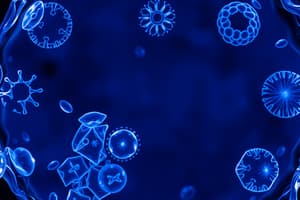Podcast
Questions and Answers
What primarily distinguishes chromosomes from chromatin?
What primarily distinguishes chromosomes from chromatin?
- Chromosomes contain RNA, while chromatin contains only DNA.
- Chromosomes are tightly coiled DNA, while chromatin is loosely coiled DNA. (correct)
- Chromosomes are found in prokaryotic cells, while chromatin is found in eukaryotic cells.
- Chromosomes are linear, while chromatin is circular.
In which phase of the mitotic cycle does the nuclear envelope break down?
In which phase of the mitotic cycle does the nuclear envelope break down?
- Prophase (correct)
- Telophase
- Anaphase
- Metaphase
What is the role of the Golgi Complex in a cell?
What is the role of the Golgi Complex in a cell?
- Cell packaging and transporting materials (correct)
- Synthesis of ATP
- Site of photosynthesis
- Cell membrane formation
What occurs during telophase in the cell cycle?
What occurs during telophase in the cell cycle?
What is the primary function of the endoplasmic reticulum?
What is the primary function of the endoplasmic reticulum?
Which of the following statements about the Synthesis Phase is correct?
Which of the following statements about the Synthesis Phase is correct?
What is a distinguishing feature of prokaryotic cells?
What is a distinguishing feature of prokaryotic cells?
In which phase do sister chromatids begin to move toward opposite poles?
In which phase do sister chromatids begin to move toward opposite poles?
Which statement is false regarding cyclin/CDK complexes?
Which statement is false regarding cyclin/CDK complexes?
What is the role of cholesterol in cell membranes?
What is the role of cholesterol in cell membranes?
Which of the following is a feature of eukaryotic cells?
Which of the following is a feature of eukaryotic cells?
Which organelle is involved in energy production within the cell?
Which organelle is involved in energy production within the cell?
During which phase do cells prepare to form a cell plate in plant cells?
During which phase do cells prepare to form a cell plate in plant cells?
Flashcards are hidden until you start studying
Study Notes
Cell Cycle and Division
- Kinases and Cyclins are crucial proteins that act as checkpoints during each stage of Interphase.
- DNA replication occurs during the Synthesis Phase of the cell cycle, which is essential for cell division.
- In the Mitotic Phase, chromosomes align along the equatorial plate prior to separation.
- The presence of spindle fibers attached to kinetochores is not required for a cell to proceed into S phase.
- The Cyclin/CDK complex promotes progression through the cell cycle but is not an inhibiting factor.
- Commitment to cell division occurs in the Synthesis Phase.
- Anaphase is characterized by the separation of sister chromatids to opposite poles of the cell.
- Meiosis does not occur in somatic cells; it is specific to germ cells.
- Meiosis I reduces the chromosome number by half, ensuring offspring have a diploid chromosome number.
Cell Structure and Types
- Golgi body contributes to the formation of the cell plate in plant cells during telophase.
- Both prokaryotic and eukaryotic cells feature a cell wall and flagella.
- Prokaryotic cells lack a membrane-bound nucleus, which differentiates them from eukaryotic cells.
- Bacterial cells are examples of prokaryotic cells.
- Plants and animals exemplify eukaryotic cells, which have complex structures.
Eukaryotic vs Prokaryotic Cells
- Eukaryotic cells are defined by having a nucleus, are larger and more complex, and contain membrane-bound organelles.
- Prokaryotic cells are smaller and simpler, with circular DNA and no nucleus or membrane-bound organelles.
- Age is not a distinguishing factor between prokaryotic and eukaryotic cells.
- The nucleus is responsible for controlling major cellular activities, while the cytoplasm encompasses all contents within the cell.
- Vacuoles store essential materials necessary for cellular function.
Organelles and Functions
- Mitochondria are vital for energy production within the cell.
- Ribosomes synthesize proteins, which play key roles in cell function.
- Lipids are the predominant molecular component of cell membranes.
- Cholesterol in cell membranes prevents fatty acids from aggregating.
- Glycoproteins, which are proteins with attached carbohydrates, function in cell adhesion and recognition.
Membrane Structure
- Channels and pumps in the cell membrane are formed by proteins to facilitate substance transport.
- The phospholipid bilayer of the plasma membrane restricts the free movement of ions.
- Prophase, part of the mitotic phase, is defined by the breakdown of the nuclear envelope.
- Telophase includes cytokinesis, completing cell division.
- A chromosome is a tightly coiled form of DNA, while chromatin is its loosely coiled counterpart.
Genetic Continuity and Cell Function
- Maintaining a diploid cell type post-division is necessary for producing cells that are precise copies of the parent cell.
- A diploid cell with 24 chromosomes will produce daughter cells with 12 chromosomes after meiosis.
- During telophase, the nuclear membrane is reconstructed.
- Spindle fiber dynamics facilitate the alignment of chromosomes along the cell's equatorial plate.
- The primary feature of anaphase is the segregation of sister chromatids.
- DNA in prokaryotic cells is located in the cytoplasm, while eukaryotic cells have their DNA housed within the nucleus.
- The nucleoid is the region within a prokaryotic cell where its single, circular DNA strand resides.
- Eukaryotic cells are characterized by the presence of membrane-bound organelles, in contrast to prokaryotic cells, which typically lack a nucleus.
- The cell wall serves to support plant structures.
- Lysosomes are responsible for recycling cellular components and removing waste.
- The Endoplasmic Reticulum acts as a transportation network for molecules within the cell.
- The cell membrane regulates the entry and exit of substances, maintaining homeostasis.
- The Golgi Complex functions as a packaging center for cellular products, directing them to their appropriate destinations.
Studying That Suits You
Use AI to generate personalized quizzes and flashcards to suit your learning preferences.




